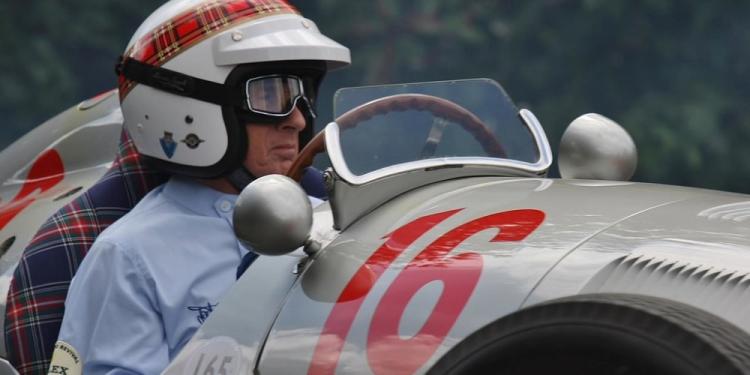Jackie Stewart’s Career in F1
Posted: March 1, 2024
Updated: March 1, 2024
-
Jackie Stewart’s career in F1 spanned only nine seasons
-
Still, he is one of the most iconic drivers in autosport

Jackie Stewart’s career in F1 spanned only nine seasons, but it left a lasting mark in the championship’s history. From 1965 to 1973, the driver became one of the most successful and iconic drivers in autosport, and it’s definitely worth remembering. The new Formula 1 season has started – bet on all Grand Prix winners at online sportsbooks in the UK!
Jackie Stewart’s Career in F1: Early Years
Jackie Stewart made his Formula 1 debut in 1965 with BRM (British Racing Motors) and won his first Grand Prix in Monza, Italy. Throughout his rookie season, Stewart showcased his talent with a win at the BRDC International Trophy and his first World Championship victory at Monza, battling closely with teammate Hill. He rounded off the year with a win, three second-place finishes, a third, a fifth, and a sixth, earning third place in the World Drivers’ Championship.
In 1966, Stewart dominated the Tasman Series but faced challenges in F1 due to the unreliability of the BRM cars. Despite this, he managed to win the Monaco Grand Prix. However, his season was marred by an accident at the Belgian Grand Prix, which fuelled his crusade for improved safety in F1. Despite setbacks, he succeeded in other racing events, winning the Rothmans 12 Hour International Sports Car Race and nearly clinching victory at the Indianapolis 500.
The following year, Stewart faced difficulties with BRM, though he secured a victory at the New Zealand Grand Prix. His F1 performances were limited to a second-place finish at Spa, where he had to improvise by driving with one hand. Nonetheless, he found success in F2 events and other racing competitions popular at online gambling sites in the UK, showcasing his versatility and skill on the track.
World Championships with Matra and Tyrrell
In 1968, Jackie Stewart’s career in F1 made a new turn as he switched to the Matra team. Why was it significant? Matra was an up-and-coming team at the time. He secured wins in challenging conditions at Zandvoort and the Nürburgring despite missing races due to injury. Although he won at Watkins Glen, a car failure in Mexico City cost him the driver’s title to Hill.
The following year, Stewart dominated races driving the Matra MS80-Cosworth, winning by significant margins at tracks like Montjuïc, Clemont-Ferrand, and Silverstone. His wins at Kyalami, Zandvoort, and Monza earned him the world championship. Stewart’s feat of leading at least one lap in every Grand Prix that year remains unmatched.
In 1970, engine disagreements led Matra and Tyrrell/Stewart to part ways. Stewart raced a March 701-Cosworth, winning the Race of Champions and Jarama. However, the development of the car lagged behind Lotus’s new model. The debut of the Tyrrell 001-Cosworth showed potential, though plagued by initial issues. Stewart, backed by Elf sponsorship, continued to race in a car painted French Racing Blue, participating in F2 and briefly in Can-Am. You can bet on both at Bet365.
Stewart clinched the 1971 F1 World Championship with the Tyrrell 003-Cosworth, triumphing in multiple races across different continents. He also competed in the Can-Am series, finishing third despite battling mononucleosis and frequent transatlantic travel for media obligations.
Health issues continued in 1972, with Stewart missing a Grand Prix due to gastritis. Nevertheless, he secured wins in several races and finished second in the championship standings. Stewart also competed in the European Touring Car Championship, achieving notable success alongside F1 teammate François Cevert.
Last year in Formula 1
Stewart continued his success with Tyrrell in 1973, winning his third World Championship at Monza, finishing 4th despite driving 20th and last at some point in the race. His 1973 championship victory came amidst tragedy, as his close friend and teammate François Cevert died in a crash during practice for the United States Grand Prix at Watkins Glen, which was the last race of the season. Stewart embarked on a solo investigation on the track in his car to gather insights. He found that he personally favored navigating The Esses complex in fourth gear while driving the Tyrrell.
This choice positioned him at the lower range of the engine’s revolutions, resulting in better control and reduced nervousness in the car, albeit with slightly decreased throttle response. Contrarily, Cevert opted for third gear, aiming to operate at the higher end of the engine’s power spectrum. This approach represented a compromise due to the necessity of accelerating through the series of corners.
The end of Jackie Stewart’s career in F1 after that season was ironic, given that he had encouraged Cevert to remain with the team to assume a leadership role starting in 1974.
An advocate for safety in F1
After retiring from racing in 1973, Jackie Stewart remained active in motorsport as a commentator, team owner, and safety advocate. Stewart joined forces with Louis Stanley, the BRM team boss, to advocate for enhanced emergency services and improved race-track safety barriers. He expressed concern about the lack of crash barriers at specific circuits, highlighting the danger of fuel containers in the pit lane and the risk of cars crashing into the pits.
In response, Stewart took proactive measures, such as hiring a private doctor for all his races and attaching a spanner to his BRM’s steering shaft for emergency use. He pushed for mandatory seat belt usage and full-face helmets for drivers, now standard safety measures in modern racing.
Additionally, Stewart urged track owners to update their facilities, organizing driver boycotts of races at Spa-Francorchamps in 1969, the Nürburgring in 1970 (with support from his friend Jochen Rindt), and Zandvoort in 1972 until safety measures like barriers, run-off areas, and medical facilities were improved. While some drivers and press members believed Stewart’s safety advocacy detracted from the sport, track owners and race organizers hesitated because of the added costs involved. If you are interested in other remarkable drivers, read about Niki Lauda best moments in F1.
Click here to try the best odds at bet365 Sportsbook












